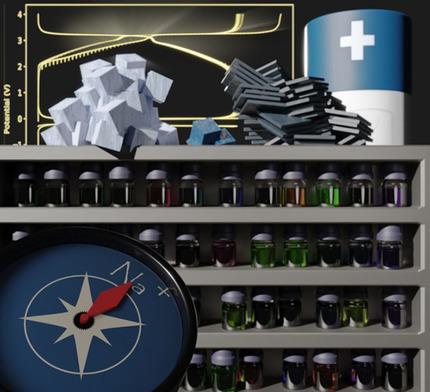当前位置:
X-MOL 学术
›
Batteries Supercaps
›
论文详情
Our official English website, www.x-mol.net, welcomes your feedback! (Note: you will need to create a separate account there.)
An Attempt to Formulate Non‐Carbonate Electrolytes for Sodium‐Ion Batteries
Batteries & Supercaps ( IF 5.1 ) Pub Date : 2020-12-24 , DOI: 10.1002/batt.202000252 Ronnie Mogensen 1 , Simon Colbin 2 , Reza Younesi 3
Batteries & Supercaps ( IF 5.1 ) Pub Date : 2020-12-24 , DOI: 10.1002/batt.202000252 Ronnie Mogensen 1 , Simon Colbin 2 , Reza Younesi 3
Affiliation

|
Non‐aqueous carbonate solvents have been the main choice for the development of lithium‐ion batteries, and similarly most research on sodium‐ion batteries have been performed using carbonate‐based solvents. However, the differences between sodium and lithium batteries – in term chemistry/electrochemistry properties as well as electrode materials used – open up opportunities to have a new look at solvents that have attracted little attention as electrolyte solvent. This work investigates properties of a wide range of different solvent classes in the context of sodium‐ion battery electrolytes and compares them to the performance of propylene carbonate. The thirteen solvents studied here include one or several members of glymes, carbonates, lactones, esters, pyrrolidones, sulfones, and alkyl phosphates. Out of those, five outperforming solvents of γ‐butyrolactone (GBL), γ‐valerolactone (GVL), N‐methyl‐2‐pyrrolidone (NMP), propylene carbonate (PC), and trimethyl phosphate (TMP) were further investigated using additives of ethylene sulfite (ES), vinylene carbonate (VC), fluoroethylene carbonate (FEC), prop‐1‐ene‐1,3‐sultone (PES), sulfolane (TMS), tris(trimethylsilyl) phosphite (TTSPI), and sodium bis(oxalato)borate (NaBOB). The solvents TMS and tetraethylene glycol dimethyl ether (TEGDME) were tested in 1 : 1 mixtures by volume with the co‐solvents; NMP, dimethoxyethane (DME), and TMP. All electrolytes used NaPF6 as the salt. Primary evaluation relied on electrochemical cycling of full‐cell sodium‐ion batteries consisting of Prussian white cathodes and hard‐carbon anodes. Galvanostatic cycling was performed using both two‐ and three‐electrode cells, in addition, cyclic and linear sweep voltammetry was used to further evaluate the electrolyte formulations. Moreover, the resistance was measured on the anode and cathode, using Intermittent current interruption (ICI) technique.
中文翻译:

尝试配制用于钠离子电池的非碳酸电解质
非水碳酸盐溶剂一直是锂离子电池开发的主要选择,同样,大多数钠离子电池的研究都是使用碳酸盐基溶剂进行的。但是,钠电池和锂电池之间的区别-在化学/电化学特性以及所用电极材料方面-开启了重新审视作为电解质溶剂鲜为人知的溶剂的机会。这项工作研究了钠离子电池电解质中各种不同溶剂类别的特性,并将它们与碳酸亚丙酯的性能进行了比较。此处研究的十三种溶剂包括甘醇二甲酸酯,碳酸盐,内酯,酯,吡咯烷酮,砜和烷基磷酸酯中的一种或几种。在这些之中,使用亚硫酸亚乙酯(ES),碳酸亚乙烯酯(VC),碳酸氟亚乙酯(FEC),prop-1的添加剂进一步研究了N-甲基-2-吡咯烷酮(NMP),碳酸亚丙酯(PC)和磷酸三甲酯(TMP)烯-1,3-磺内酯(PES),环丁砜(TMS),亚磷酸三(三甲基甲硅烷基)酯和双(草酸酯)硼酸钠(NaBOB)。溶剂TMS和四甘醇二甲醚(TEGDME)与助溶剂按体积比为1:1的混合物进行了测试;NMP,二甲氧基乙烷(DME)和TMP。所有电解液均使用NaPF 6作为盐。初步评估依赖于由普鲁士白色阴极和硬碳阳极组成的全电池钠离子电池的电化学循环。使用两电极和三电极电池进行恒电流循环,此外,使用循环和线性扫描伏安法进一步评估电解质配方。此外,使用间歇电流中断(ICI)技术在阳极和阴极上测量电阻。
更新日期:2020-12-24
中文翻译:

尝试配制用于钠离子电池的非碳酸电解质
非水碳酸盐溶剂一直是锂离子电池开发的主要选择,同样,大多数钠离子电池的研究都是使用碳酸盐基溶剂进行的。但是,钠电池和锂电池之间的区别-在化学/电化学特性以及所用电极材料方面-开启了重新审视作为电解质溶剂鲜为人知的溶剂的机会。这项工作研究了钠离子电池电解质中各种不同溶剂类别的特性,并将它们与碳酸亚丙酯的性能进行了比较。此处研究的十三种溶剂包括甘醇二甲酸酯,碳酸盐,内酯,酯,吡咯烷酮,砜和烷基磷酸酯中的一种或几种。在这些之中,使用亚硫酸亚乙酯(ES),碳酸亚乙烯酯(VC),碳酸氟亚乙酯(FEC),prop-1的添加剂进一步研究了N-甲基-2-吡咯烷酮(NMP),碳酸亚丙酯(PC)和磷酸三甲酯(TMP)烯-1,3-磺内酯(PES),环丁砜(TMS),亚磷酸三(三甲基甲硅烷基)酯和双(草酸酯)硼酸钠(NaBOB)。溶剂TMS和四甘醇二甲醚(TEGDME)与助溶剂按体积比为1:1的混合物进行了测试;NMP,二甲氧基乙烷(DME)和TMP。所有电解液均使用NaPF 6作为盐。初步评估依赖于由普鲁士白色阴极和硬碳阳极组成的全电池钠离子电池的电化学循环。使用两电极和三电极电池进行恒电流循环,此外,使用循环和线性扫描伏安法进一步评估电解质配方。此外,使用间歇电流中断(ICI)技术在阳极和阴极上测量电阻。












































 京公网安备 11010802027423号
京公网安备 11010802027423号